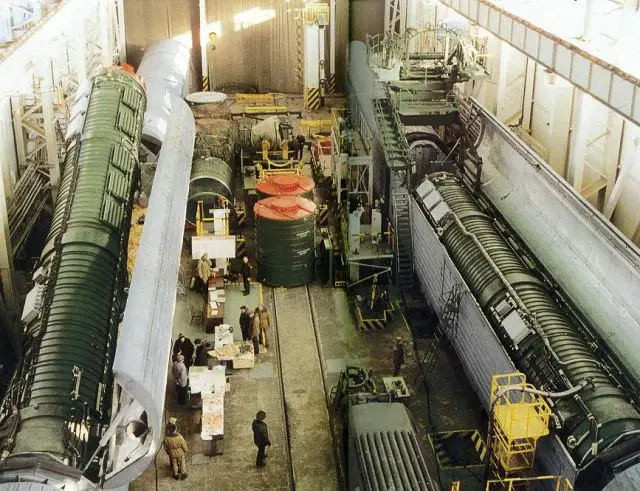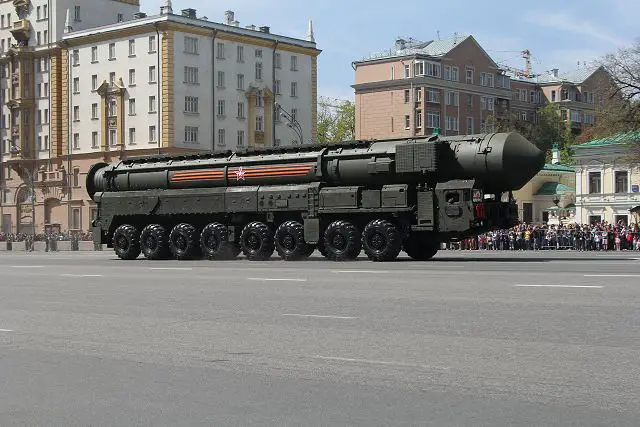Breaking news
New Russian Barguzin rail-mobile intercontinental balistic missile could be tested end of this year TASS 12305164.
| 2016
|
|
|||
|
Defence & Security News - Russia
|
|||
|
|
|||
| New Russian Barguzin rail-mobile intercontinental balistic missile could be tested end of this year. | |||
|
Russia’s defense industry continues the development of the Barguzin rail-mobile intercontinental ballistic missile (ICBM) system, expert Vladimir Tuchkov writes in an article published by the Svobodnaya Pressa online news agency.
|
|||
|
|
|||
 Loading of RS-22 missile in rail-mobile launcher Loading of RS-22 missile in rail-mobile launcher |
|||
|
|
|||
|
Moscow Institute of Thermal Engineering General Designer Yuri Solomonov said that drop tests of the Barguzin ICBM were scheduled for the fourth quarter of this year. Based on their outcome, a decision will be made on the start of the full-fledged missile system development, including the transfer of the technology to a manufacturing plant. The fielding of the Barguzin with the Strategic Missile Force is due in 2019 or 2020.
The decision on developing the rail-mobile ICBM system was taken in 2012. Drop tests are due soon to test the expulsion of the missile from its launch tube by means of its solid-propellant expulsion charge without starting its sustainer engine. The Yuzhnoye Design Bureau began to develop the RT-23UTTKh Molodets rail-mobile ICBM system in the mid-1970s. The Molodets used the 15Zh61 solid-fuel ICBM with a multiple individually-targeted re-entry vehicle (MIRV) warhead. The first train carrying three ICBMs became operational in 1989. The number of ICBM trains totaled 12 in 1991. The Molodets rail-mobile ICBM system was disguised as an ordinary civilian maintenance train, with three carriages looking like compartment cars and 14 like reefers. The train included a petrol, oil and lubricant (POL) tank car and three diesel locomotives hauling three ICBMs weighing 100 tons each. The missile train had the 28-day self-contained operation capability and a crew of over 70 troops. Once alerted, the crew had 3 min. to conduct the launch. The train would stop, and a special device would move the contact line aside and ground it. A launch tube would be set vertically and the missile would be propelled from it by the expulsion charge. Then, the ICBM’s solid-propellant booster motor would take it away from the train to prevent damage to the rails and launcher by its plume. With this done, the sustainer would kick in. This kind of basing had a number of strengths. It offered increased stealth of the system. The Molodets also featured huge immunity to the nuclear exposition’s blast wave. A unique nuclear blast simulation was conducted at the Plesetsk Proving Ground in 1991. A 20-m-high pile of antitank mines withdrawn from East Germany was laid near a missile train (the actual distance remains undisclosed). The blast’s yield accounted for 1 kt of TNT. The explosion left a crater 80 m in diameter and 10 m in depth. The acoustic pressure in the manned compartments of the train stood at 150 dB. The missile launcher worked smoothly right after the blast. |
|||
|
|
|||
 RS-24 Yars ICBM mobile intercontinental ballistic missile RS-24 Yars ICBM mobile intercontinental ballistic missile |
|||
|
|
|||
|
The rail-mobile missile system’s designers had to resolve numerous specific problems that they had not encounter when developing ordinary ICBMs. A key problem was that even the expulsion of the missile from the launch tube produced so much strain on the rail track that it could bend the rails. A complex damping solution involving the cars adjacent to the launcher’s one was used for preventing damage to the railroad embankment and ties.
These complex solutions will be used in the advanced Barguzin rail-mobile ICBM system as well. To a large degree, this is a reason why its development tempo has been so high. In 1991, Washington insisted on only half of the ICBM trains being out on mission at the same time. Soon, even this right was axed, when the trains were allowed to go only 20 km away from their bases. Under the START II Treaty, Russia was obliged to destroy both the silo-based and rail-mobile RT-23UTTKh missiles. The Soviet rail-mobile ICBM systems were decommissioned in 2005. At the same time, the New START Treaty does not ban the development of armament like that. Russia has to respond to US ‘initiatives’, including America’s withdrawal from the ABM Treaty, missile defense deployment in Europe and NATO’s approach to Russia’s border. The Prompt Global Strike (PGS) concept is an ‘initiative’ like that. It implies a massive global conventional attack on any country within an hour. This kind of strike is called ‘disarming’. The development of the Barguzin rail-mobile ICBM system is our response to the concept. The prime contractor for the Barguzin is the Moscow Institute of Thermal Engineering. Certainly, the Barguzin and Molodets are different. They are divided by 30 years, during which time technology has progressed. The designers have to meet the stringent dimension requirements set by the present-day trains so that the missile train looks identical to an ordinary one. For instance, the missile in its launch tube must fit a standard refrigeration car measuring 24 m long. The key component of the rail-mobile ICBM system is the missile. The Barguzin train will carry six ICBMs derived from the RS-24 Yars (NATO reporting name: SS-27 Mod 2) ICBM. The RS-24 features a much higher effectiveness than the RT-23UTTKh, because it has a much higher ability to penetrate missile defenses owing to a whole number of solutions available to it. The missile features a short ascent phase, when its sustainer is on. Its MIRVs are fitted with advanced electronic warfare equipment and electromagnetic shielding. The Yars’s accuracy is higher to boot, expert Vladimir Tuchkov writes in his article on the Svobodnaya Pressa website |
|||
|
|
|||
|
© Copyright 2016 TASS. All rights reserved. This material may not be published, broadcast, rewritten or redistributed.
|
|||



















